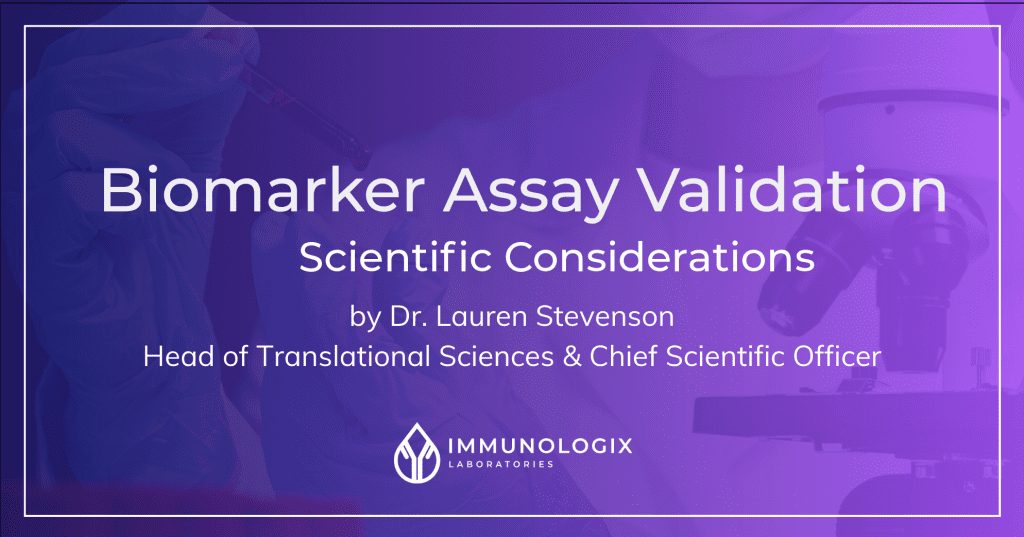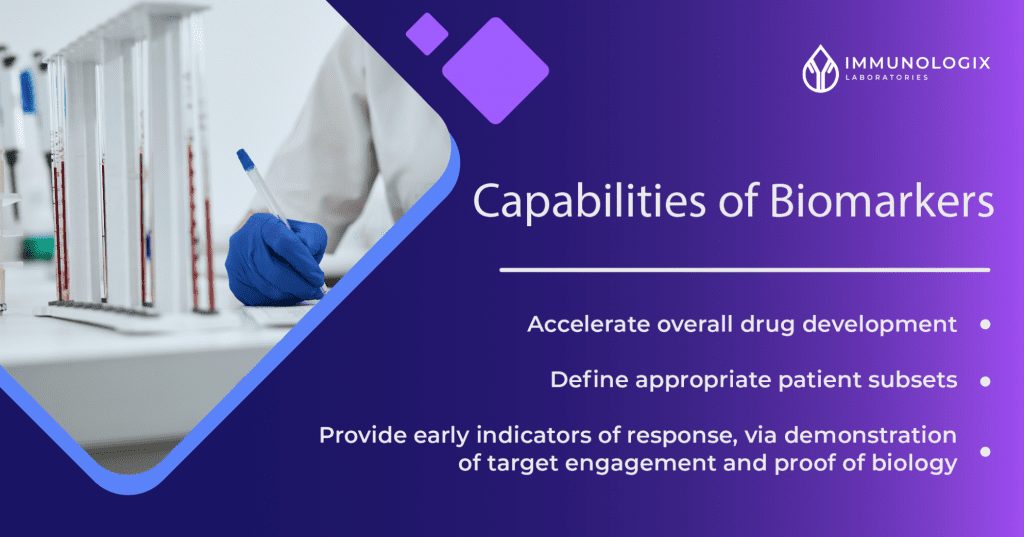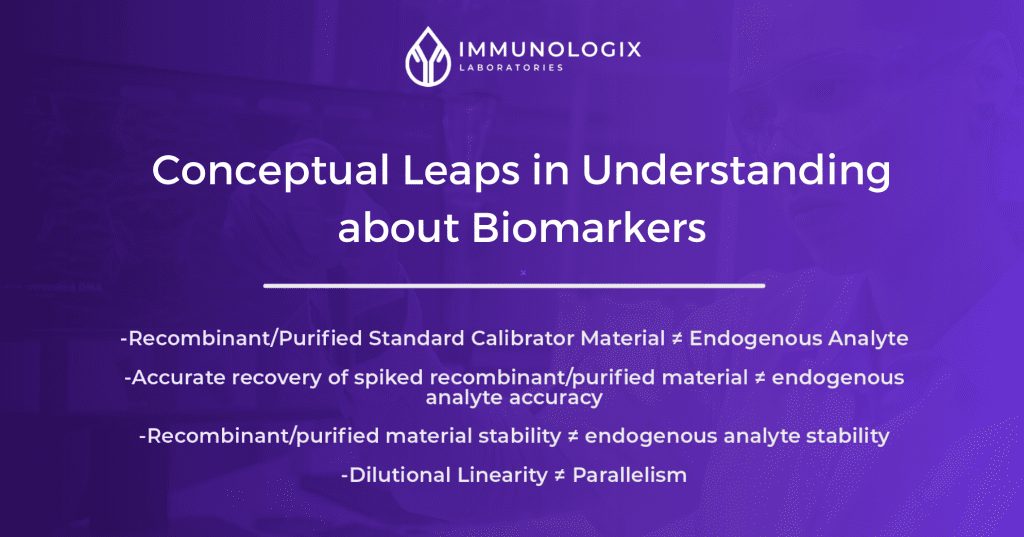Biomarker Assay Validation

Biomarker Assay Validation: Scientific Considerations
As defined by the BeST glossary, a biomarker is a characteristic that is measured as an indicator of normal biological processes, pathogenic processes, or biological responses to an exposure or intervention, including therapeutic interventions. Bioanalytical method validation of biomarker assays ensures that the method reliably measures the biomarker of interest to support its application in drug development.

Since biomarkers can accelerate overall drug development, define appropriate patient subsets and provide early indicators of response, there has been great interest and robust discourse regarding the discovery and development of biomarkers used in aiding drug development and improving patient care.
However, due to their broad capabilities, biomarkers require a unique approach to assay development and validation; one that is not defined by specific, prescriptive rules, but instead addresses their specific contexts of use.
This blog post will address the following as it relates to biomarker assay validation:
- Measuring Biomarker Assay Performance
- Biomarker Assays vs. PK Assays
- Guidance for Biomarker Assay Validation
Measuring Biomarker Assay Performance
The ability to reliably measure biomarker assay performance is crucial to their successful deployment. Scientists and regulators have debated how to best define performance criteria and validate methodology for biomarker assays. While many have proposed that biomarker assays be held to the standards of PK assays, others have advocated a Fit-for-purpose (FFP) approach as first proposed in the seminal Lee paper Fit-for-purpose method development and validation for successful biomarker measurement. The concept fueling FFP is “application of appropriate scientific rigor,” however, as discussions on biomarker validation continued, it was unfortunately interpreted by some as instead meaning “lacking in rigor.”
Biomarker Assays vs. PK Assays
In September 2015, the AAPS Crystal City VI Workshop: Bioanalytical Method Validation for Biomarkers raised the volume on the debate. There, the phrase “Biomarker assays are not PK assays” was first uttered, and reiterated, and it has served as a key concept ever since. Scientists and regulators were urged to stop misapplying a PK-assay mindset. Since PK assays share the same context of use, a single guidance may reasonably be expected to ensure that they are fit for their purpose. But biomarker assays need to be viewed in their own right and instead must be assessed in context. To set appropriate performance criteria for a given biomarker assay, one must focus on the specific question being asked and possess an understanding of the pertinent biology and biological variability of the biomarker to determine whether the assay is suitable to adequately address the question.
Crystal City VI (CCVI) paved the way to more widespread discussion focused on biomarkers, eventually leading to the June 2017 Public Workshop on Scientific and Regulatory Considerations for the Analytical Validation of Assays Used in the Qualification of Biomarkers in Biological Matrices. Since then, consensus regarding the not-PK-assay nature of biomarkers has continued to build, with scientific alignment on several key concepts occurring by the end of 2018 and discussions continuing at AAPS and EBF workshops in 2019 and 2020. The concept of Context of Use (COU), a restatement of CCVI’s “focus on the specific question being asked” has now entrenched itself within the biomarker community.
Other conceptual leaps in understanding have included:
- Recombinant/Purified Standard Calibrator Material ≠ Endogenous Analyte
- Accurate recovery of spiked recombinant/purified material ≠ endogenous analyte accuracy
- Recombinant/purified material stability ≠ endogenous analyte stability
- Dilutional Linearity ≠ Parallelism

Guidance for Biomarker Assay Validation
The breadth of biomarkers and the questions they address do not allow for a concrete set of rules, and therefore it is not possible to create a singular, prescriptive guidance for biomarker assay validation. Any recommendations and guidelines that one might propose must be suitably broad and flexible, and could be distilled to:
- Be a scientist
- Embrace and own FFP
- Demand COU
Be a scientist indicates the need for biomarker scientists to accept a high level of accountability in determining the right assessments to ensure that their assays meet the biomarker’s needs. In order to do this, scientists must embrace and own FFP, understanding it as the need to “do good science” and “get it right.” The ‘purpose’ in FFP is COU. The biomarker scientist must be the determinant of what level of assay performance is needed to meet a given COU. One must demand COU because without COU, there can be no assay validation.
Biomarker science does not adhere to a black and white rule book and is not for everyone. Biomarker assays serve unique and varied COUs, which cannot be addressed by one-size-fits-all guidance. Scientists must think critically, generate data, and continue robust discourse. Most importantly, they must consider the best interests of the patients who are counting on biomarker scientists to do the right assay at the right time to generate the right data to improve their lives.
If you’re interested in learning more about how Immunologix can assist you with biomarker sciences, contact us here.
#BeAScientist
Author Bio:
Dr. Lauren Stevenson
Chief Scientific Officer & Head, Translational Sciences
Lauren is a recognized industry-wide thought leader in biomarker development and large molecule bioanalysis and immunogenicity. She brings 20+ years of drug development experience, building and leading scientific teams that set strategies for developing PK, immunogenicity and biomarker assays in support of therapeutic programs that span multiple modalities and disease indications. Lauren’s teams have a strong track record of reliably delivering high caliber science coupled with increased efficiencies while influencing industry best practices and regulatory guidance. Externally, Lauren has authored multiple white papers and engages the broader industry and regulatory agencies as an invited speaker and course instructor in multiple forums each year.
Lauren continues to build a world class team of scientists who partner directly with clients to provide translational strategies, facilitate regulatory engagements and deliver the assays, datasets and integrated analyses to advance drug development programs.
